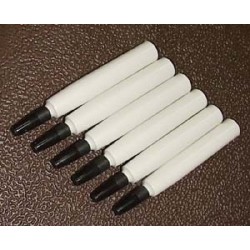Dyne Testing Markers And Non Toxic Pens - Things You Need To KnowDyna testing is the technology to measure surface wettability where low surface wettability is a sign of poor adhesion of inks, glues, and coatings. Polymer-based substances have a low surface wettability which means it does not have good surface energy. It is possible to improve the adhesive property of the surface by first treating it in the right manner using corona or plasma. This article is about the significance of dyne testing, how non toxic pens are used for the purpose of testing and its special characteristics.
Significance of Dyne testing
The Dyne level is vital for the process of correct adhesion since it is also a measure of the surface energy which affects the wettability of a substrate and it influences the effects of applying glue to the substrate. The reason being that in order for the glue to bond in the right manner it needs to be able to wet the surface of the substrate.
Dyne level is very important since if the glue is not able to wet the surface in the right manner, it will result in a poor bond. The main requirement for good bonding is excellent surface energy. The dyne level of the substrates is a good method of identifying if there is likely to be an issue with the substrate. The surface tension of glue is required to be less than the surface energy of the substrate. Thus for an optimal bond between the glue and the substrate, the dyne level should ideally be 45 or higher.

Tools to Measure Dyne Testing
Dyne test markers are the perfect tool useful to measure the surface energy of a wide range of substrates, especially in the packaging industry. The importance of surface energy has already been stated in this article. These are non-toxic pens markers, each filled with a special link that has a specific dyne level. This is a testing method that is based on the ISO 8296 method of testing the surface energy of polyethylene film.
The testing process that involves the use of dyne test markers is a quick and simple one. Clean a small section of the substrate and also make sure the section is not damaged. It is important to perform the testing process several times before confirming your results. The test involves using the dyne pen to make a mark on the surface. It is important to observe the type of mark created and check the beading of the ink. If there is no beading of the ink within two seconds, repeat the process using a test marker that has a higher number. The testing process should stop once the beading occurs on using one of the pens.
The dyne level can now be obtained and is the highest dyne number marker that was able to make a line without any being. For example, if no beading occurs using pen number 38 while when using 42 there is a little beading and 46 is complete beading. The dyne number for this material can be considered to be 38-41. This level signifies the surface energy of the substrate, for example, in this case, it is approximately 38 dynes/cm.
Properties of a Dyne test Markers
The testing pen should ideally have the following properties:
- It should be easy to handle.
- Allow quick spot checks if necessary on a production floor.
- Easy to read
- It should not evaporate very fast; since the result of the marker should be displayed for a reasonable amount of time for it to be useful
- The color should ideally be highly visible.
- The pen should not be contaminated with any foreign substances.
A marker that has passed its expiry date may not function in the right manner due to several chemical reasons that might occur.
|
Article Directory /
Arts, Business, Computers, Finance, Games, Health, Home, Internet, News, Other, Reference, Shopping, Society, Sports
|